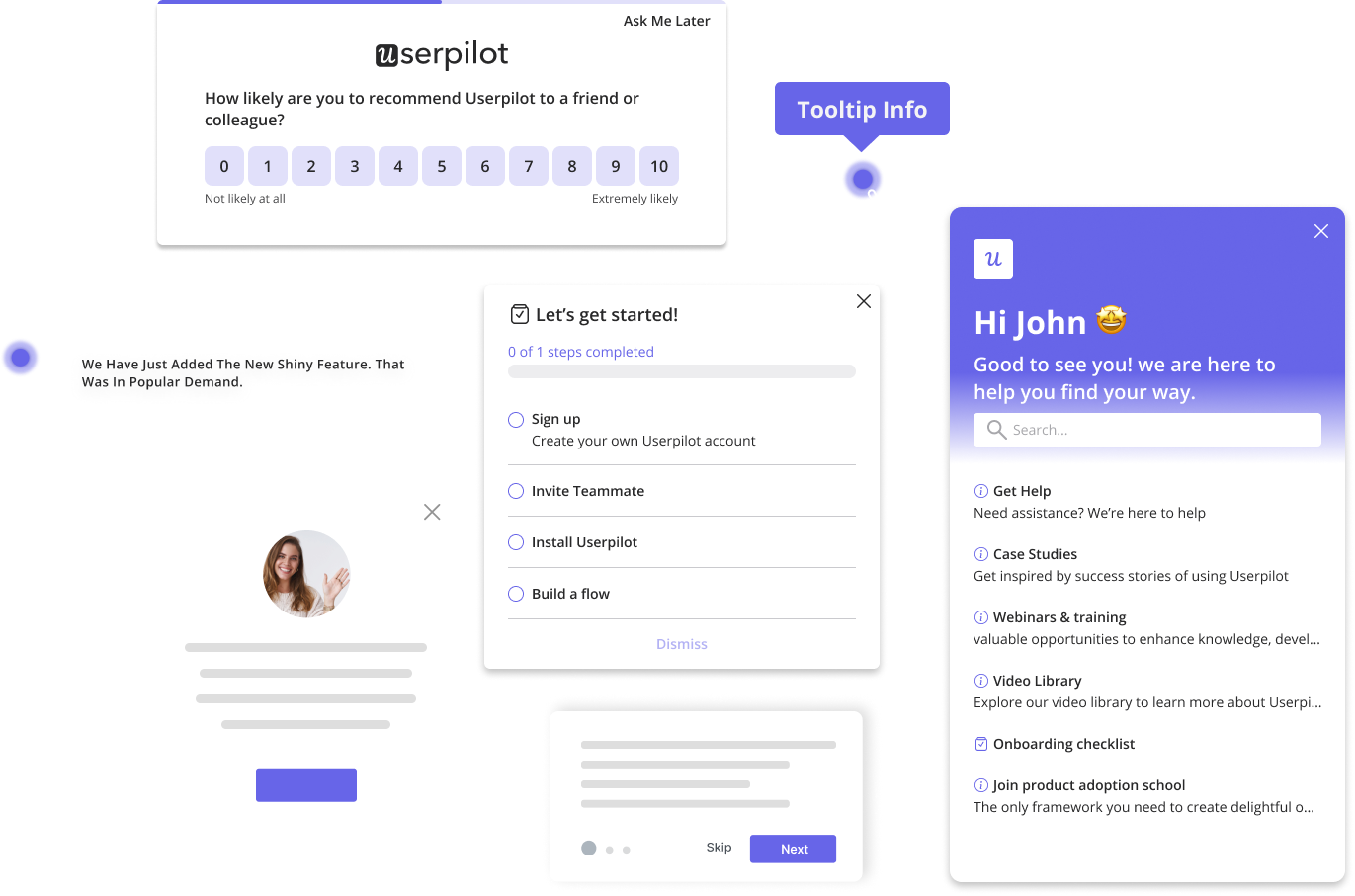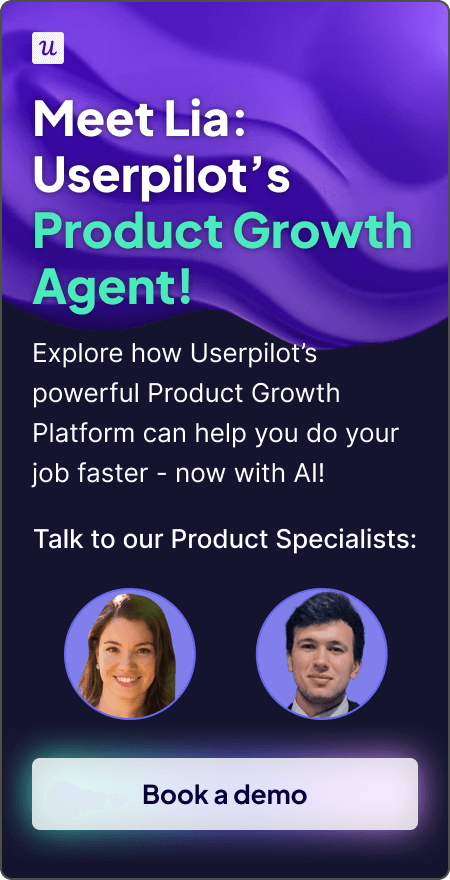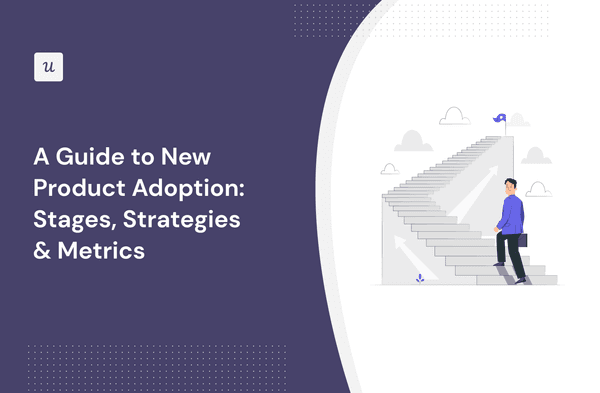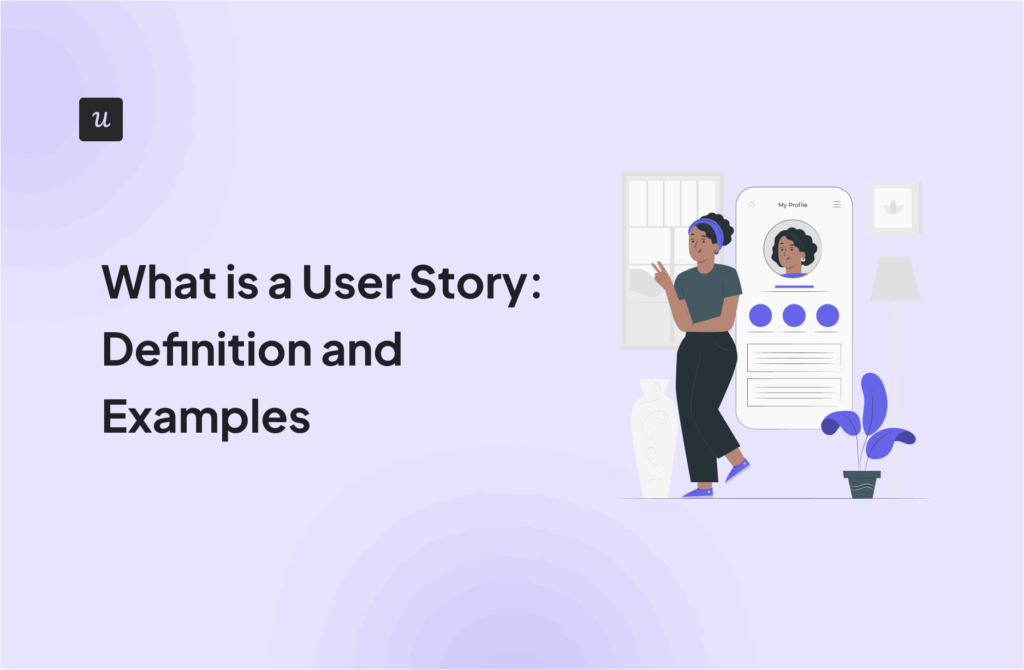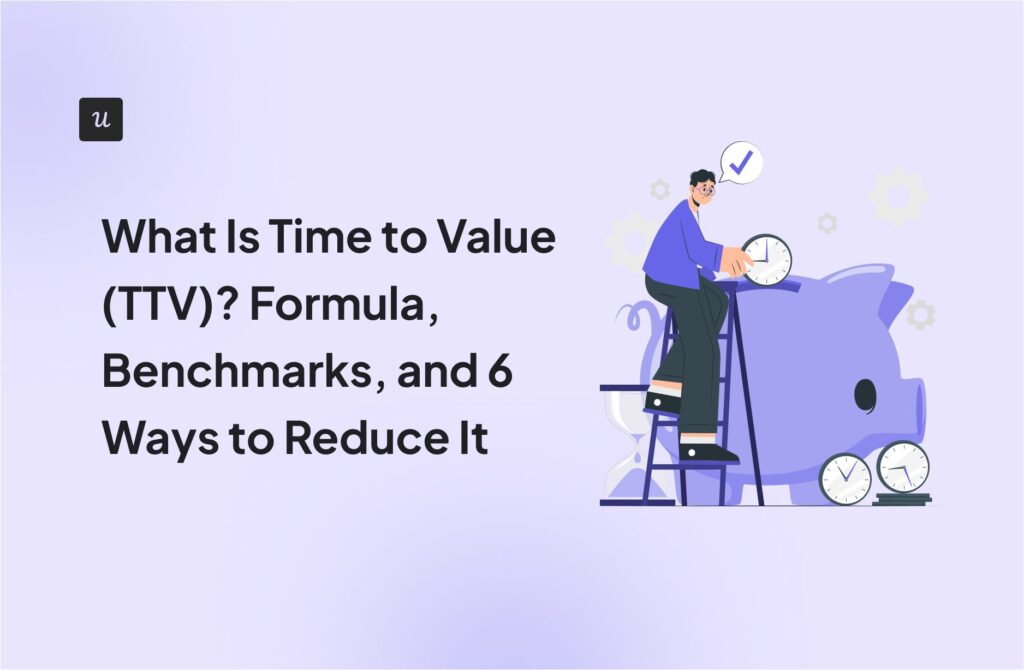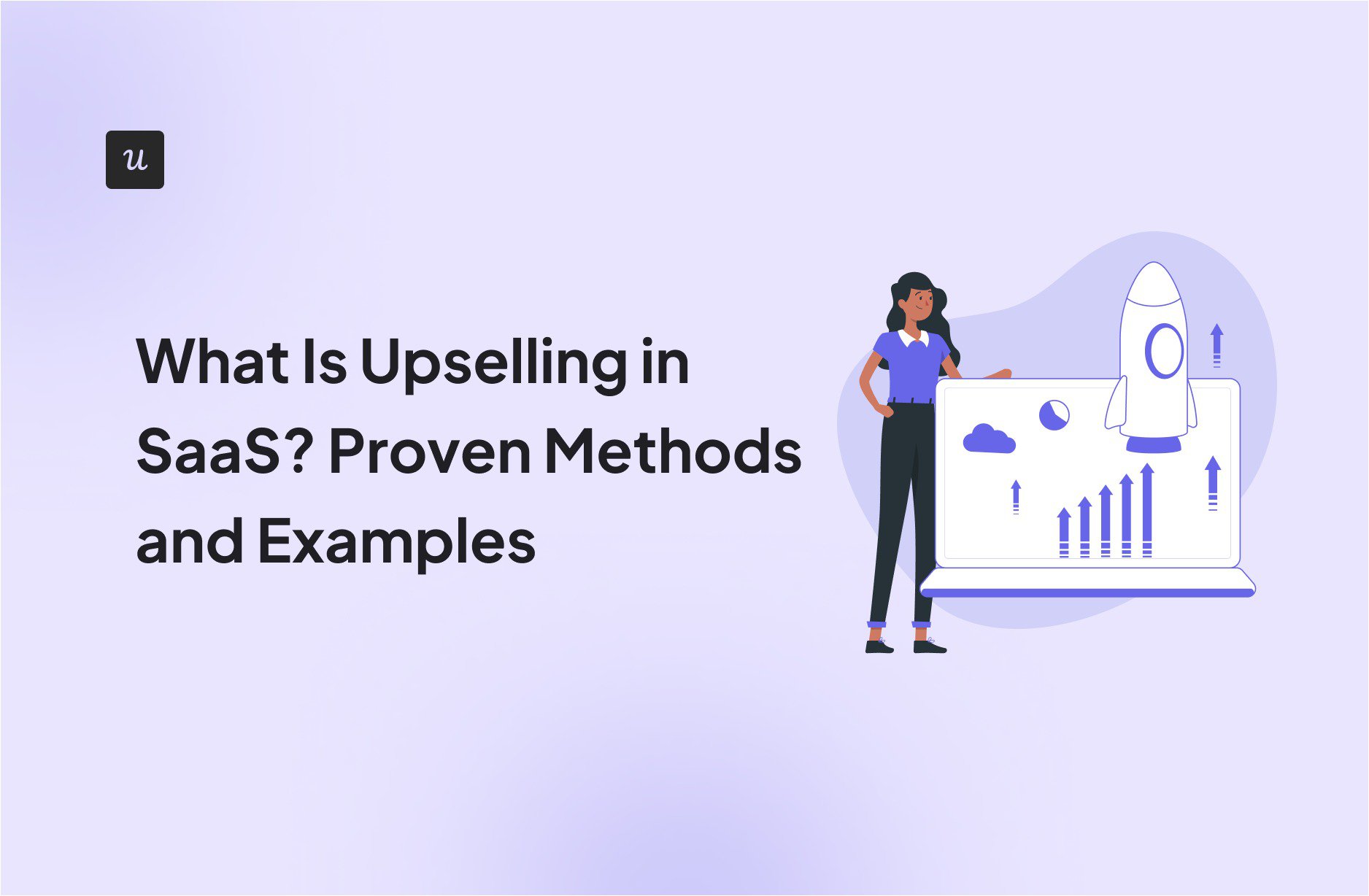
As a growth PM who’s scaled SaaS products to 8-figure ARR, I know acquisition is just the start. The real growth happens after signup: getting existing users to unlock more value from what they already have.
The math proves upselling works: you’re 60–70% likely to sell to an existing customer vs just 5–20% to a new prospect. It drives expansion revenue without acquisition costs while effectively working to upsell customers and turning casual users into power users.
In this article, I’ll break down what upselling means in SaaS, how it differs from cross-selling, the tactics that actually work, and real examples that prove it.
What’s your biggest upselling challenge right now?
Understanding your main hurdle helps in finding the right upselling strategy.
How do you currently trigger your upsell offers?
The delivery method is key to a successful upselling motion.
How do you measure the success of your upselling efforts?
Effective upselling is data-driven and tied to clear business goals.
Unlock Your Upselling Potential
It looks like you’re ready to build a powerful, data-driven upselling engine. Stop leaving money on the table and turn your existing users into your biggest growth lever.
Try Userpilot Now
See Why 1,000+ Teams Choose Userpilot
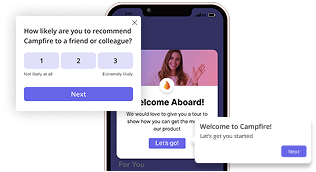
What is upselling in SaaS?
Upselling in SaaS involves guiding existing customers to upgrade to higher-tier plans or unlock premium features that align with their evolving needs.
Instead of acquiring new customers, you’re offering customers a premium product with additional functionality to increase lifetime value, higher usage limits, or advanced support.
Upselling vs. Cross-Selling
Upselling and cross-selling are often mentioned together, but smart PMs use them differently. Here’s how to think about each sales technique:
| Aspect | Upselling | Cross-Selling |
|---|---|---|
| Definition | Encouraging customers to upgrade to a higher-tier or premium version of the same product. | Suggesting additional, complementary products or features alongside the existing purchase. |
| Goal | Increase customer lifetime value from the existing product by unlocking more features, capacity, or support. | Expand the customer’s toolkit with related products that solve adjacent problems. |
| SaaS Example | Slack prompting a free team to upgrade for unlimited message history and advanced integrations. | HubSpot CRM customers adding Marketing Hub or Sales Hub modules for extended functionality. |
| Customer Experience | Better version of what they already use and trust. | More tools that broaden their overall solution. |
Most SaaS companies prioritize upselling over cross-selling initially because it’s more efficient: you don’t need to build or sell new products, and you can demonstrate clear value progression for users who are already experiencing success.
The customer relationship is established, and you’re solving capacity or feature limitations they’re actually hitting, making it easier to upsell products.
Why successful upselling is a key driver for growth
Bringing in new customers is costly and getting more expensive. Studies show that the average SaaS Customer Acquisition Cost (CAC) has climbed to over $700 per customer in recent years.
Meanwhile, 16% of new annual contract value in SaaS comes from upselling to existing customers, and 72% of SaaS sales teams saw more revenue growth through cross-selling and upselling. It’s clear why focusing on existing users is the most effective way to increase sales.
For me, upselling is about building deeper relationships with our customers. When I offer an upgrade to a premium product, I’m not trying to squeeze them. Rather than giving them solutions that enhance their experience, solve new problems, or help them grow.
And with AI reshaping how my team operates, identifying and executing these opportunities is becoming more precise and scalable.
That’s why I’m excited about this year’s Product Drive, where our founder, Yazan, will share how AI is transforming product growth, plus a major announcement about how our platform will help you spot and execute upsell opportunities more effectively.
👉 Sign up for Product Drive here to see the future of AI-powered upselling.
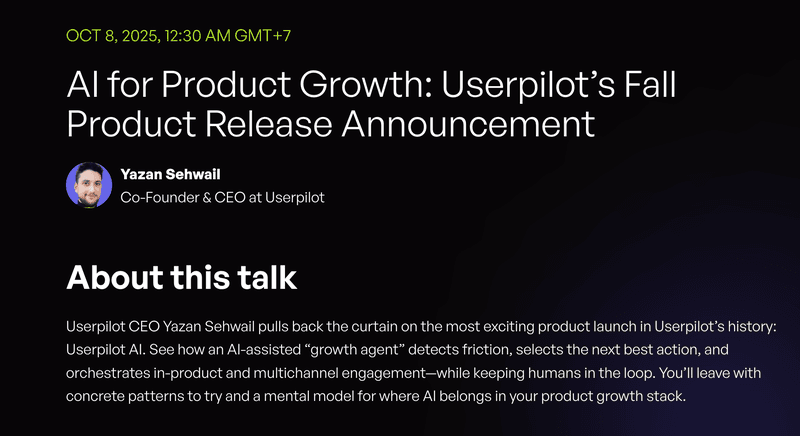
What you need to drive effective upselling
Building an effective upselling sales technique isn’t about guesswork. It means doing our homework, digging into data, and truly understanding our users. Here’s how I approach it:
1. Know your customers deeply
Before you even think about suggesting an upgrade, you need to know who you’re talking to. What are their goals? What challenges do they face every day? Where do our current offerings fall short for them? You get this understanding by gathering customer feedback, running user surveys, and analyzing their behavior in the product.
For instance, I track product usage analytics to see which features are most popular and where users might be hitting limits.
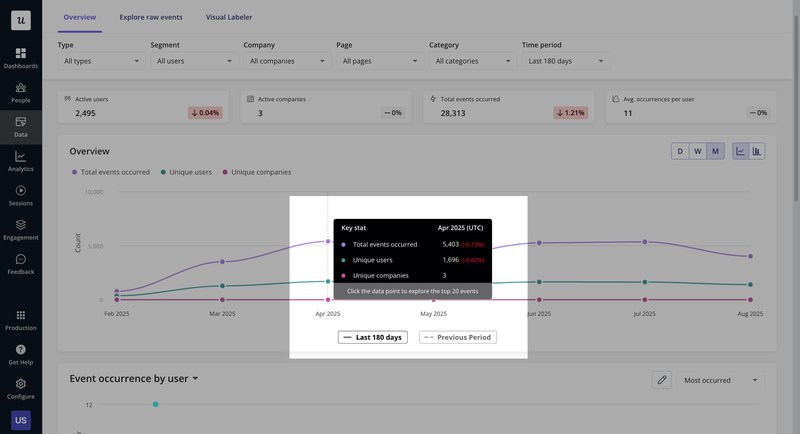
If someone is consistently exploring advanced features or bumping up against their current plan’s usage caps, that’s a clear signal they might benefit from an upgrade.
2. Segment users for better targeting
Once you have a good grasp of our customers’ needs, you group them into different segments. This is key because a “one-size-fits-all” upsell message rarely works. A user who just signed up for a free trial has different needs than a power user who’s been with us for a year.
For this, Userpilot makes customer segmentation incredibly easy. I can create dynamic groups based on behavioral data, user properties (like their role or industry), or engagement levels. This way, I can craft highly personalized offers that resonate with each group, improving our chances of a successful upsell.

3. Timing is everything (Seriously)
Imagine being offered a premium feature you don’t yet understand or need. Annoying, right? That’s why timing our upsell offers is crucial. You should aim to present upgrades at moments when users have already experienced value from our product and are naturally ready for more.
This often happens when they’re approaching a usage limit, exploring a gated feature, or hitting a major milestone in their work.
I trigger upgrade prompts at friction points, not random moments. When users hit their 10-user limit, I show a slideout with their team’s growth curve: ‘You’ve added 4 teammates this quarter. Upgrade to Pro and invite your entire department.’ The timing creates urgency because they’re literally blocked from adding the next user.
This makes each upsell offer feel helpful, avoiding pushy sales tactics, and creates a positive customer experience.
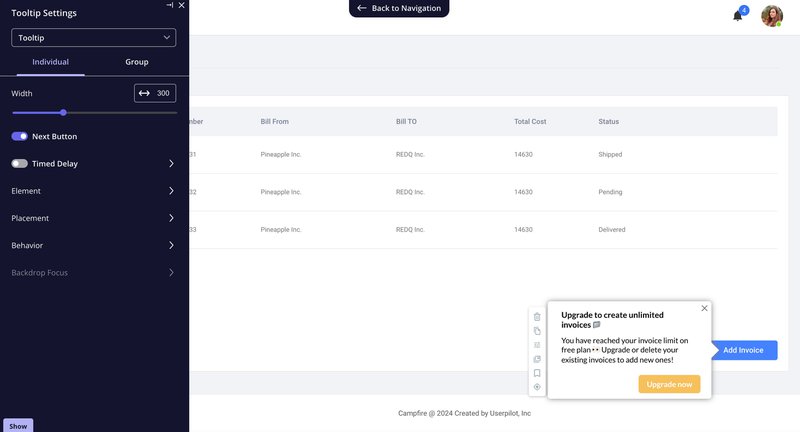
Upselling techniques don’t stop with in-app messages. You can reach your users through push notifications, emails, and product pages to keep upgrade opportunities visible across channels.
With Userpilot, you can combine in-app flows with mobile push notifications or follow-up emails, ensuring your upsell messages are timely, relevant, and aligned with each customer’s needs. This approach helps increase revenue and strengthens customer relationships by making every upsell feel like a natural next step.
4. Speak the language of value, not just features
Customers don’t buy features; they buy solutions to their problems. When I present an upsell, my team and I focus on the benefits and outcomes they’ll gain, showcasing relevant products.
Will it save them time? Boost their productivity? Give them access to premium services?
I motivate customers by highlighting how upgrades make their lives easier or work better. Sometimes, seeing is believing.
That’s where product demos or limited free trials of premium features come into play. My team showcases additional features and also leverages social proof, like testimonials or case studies, to show how other customers have benefited from upgrading.
5. Make the upgrade path seamless
Once a customer decides to upgrade, you can make the process as smooth as possible. No one wants to jump through hoops.
Our goal is a frictionless experience from interest to upgraded plan. This means clear, simple payment flows, easy access to new features, and excellent customer support.
If it’s a self-service upgrade, I ensure my user documentation is crystal clear. My customer success team is also ready to provide proactive support and personalized guidance if needed. You want them to feel supported every step of the way, reinforcing their confidence in their decision.
Key upselling techniques I rely on (with examples)
Based on these upselling examples and our own work, here are some practical upselling techniques that consistently deliver results:
Tiered plan upgrades
Tiered upgrades are the most common upselling technique in SaaS. Customers start on a lower plan, but as their usage or needs grow, you can offer them a discounted price while highlighting the added benefits of moving up, such as more storage, advanced analytics, or premium support.
This approach helps improve customer satisfaction.
With Userpilot, you can trigger contextual in-app banners or modals that compare plans and show users what they gain by upgrading. When someone reaches the upper limit of their current plan, you can use a modal with side-by-side highlights of what the premium version unlocks. This successful upselling approach feels natural rather than forced.
Example: ClickUp strategically gates premium features in its navigation menu. When users click “Audit Logs,” they don’t just see a paywall; they see exactly what they’re missing. ClickUp shows the feature benefits, offers “Upgrade to Enterprise,” and reduces risk with a money-back guarantee. This upselling technique creates aspiration rather than frustration.

Feature add-ons
Not every customer wants an entirely new plan. Sometimes they just need one specific capability. Offering add-ons is a way to give them flexibility and increase average order value without forcing them into a bigger package.
Userpilot makes this simple. You can design a tooltip that appears when users click on a premium integration or feature, explaining how it works and offering a one-click upgrade to add it to their plan. The right upsell at the right moment makes sense to users.
Example: Grammarly allows users to try premium features three times per day. Once the customer clicks and hits that limit, an upgrade prompt appears immediately. Users have already experienced the value, making the upselling feel necessary rather than pushy. This showcases additional features that provide added value.
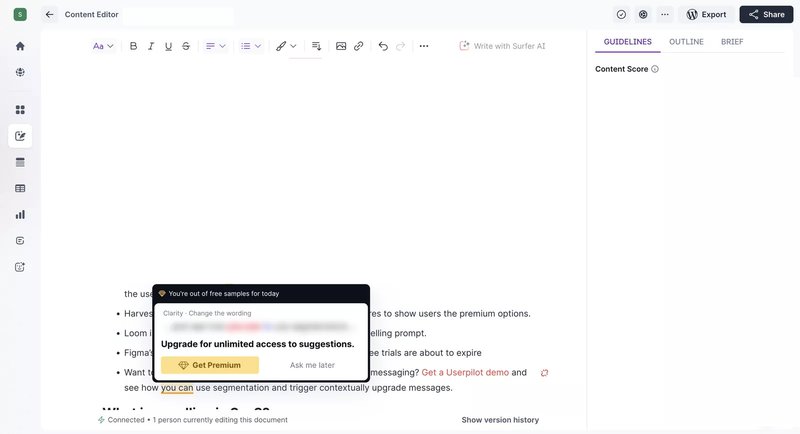
Usage-based upselling
Usage limits (tasks, contacts, storage, API calls) are natural triggers for upsells. When a customer is close to their cap, it’s the perfect time to present an upgrade as a way to continue their progress without interruption. Understanding your customer data and usage patterns is key to effective upselling, especially when they reach the checkout page.
With Userpilot, you can set up slideouts or banners that trigger once users hit 80–90% of their quota. The message congratulates them on their growth and introduces the next tier as the natural next step, creating value for expanding teams.
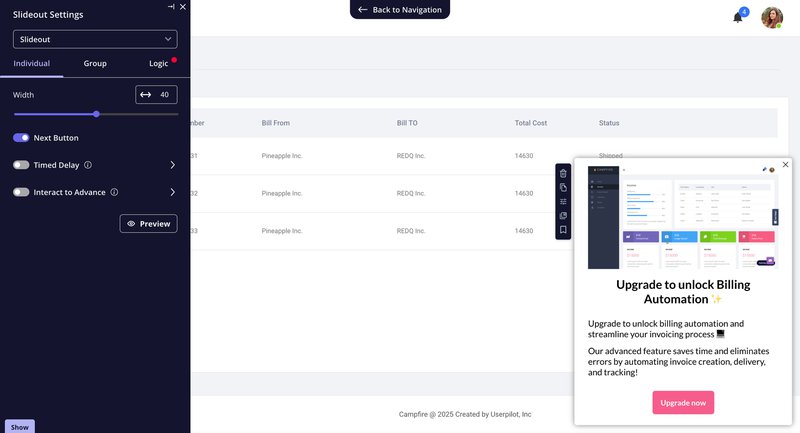
Example: Spotify caps free users at six song skips per hour. When users hit that limit mid-playlist, Spotify shows a contextual upgrade prompt highlighting Premium benefits. The timing creates immediate friction that makes the expensive version feel worth it. This upselling technique works because it interrupts active engagement.
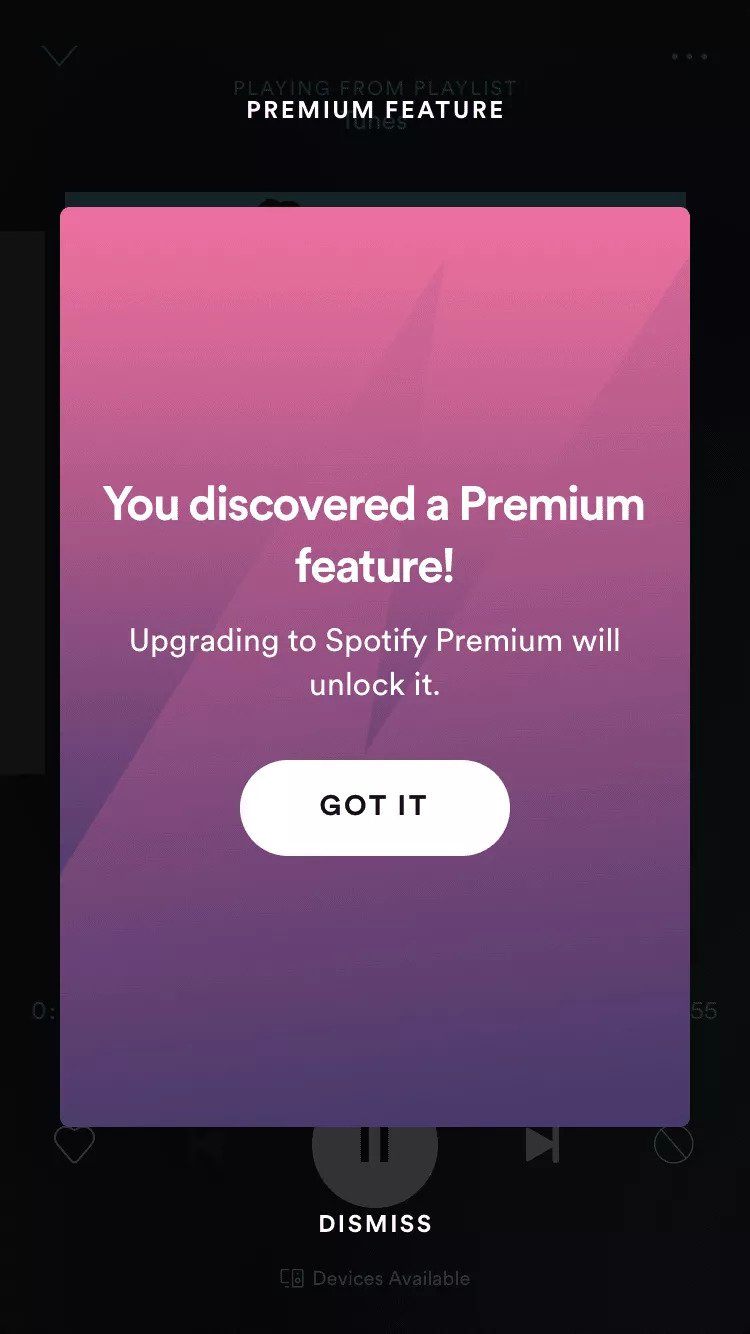
Renewal upselling
Renewals create powerful post-purchase upsell opportunities. When contracts are about to expire, you can encourage customers to move to higher tiers, add complementary products, or commit to a longer-term plan for a more expensive product. Sales professionals know this is when customer relationships are strongest.
Example: Zapier uses persistent countdown banners showing “You have 14 days to try Zapier’s paid features.” The constant visual reminder creates urgency while users are actively experiencing value. This upselling approach leverages time pressure during peak engagement, making upgrades feel necessary to continue progress.
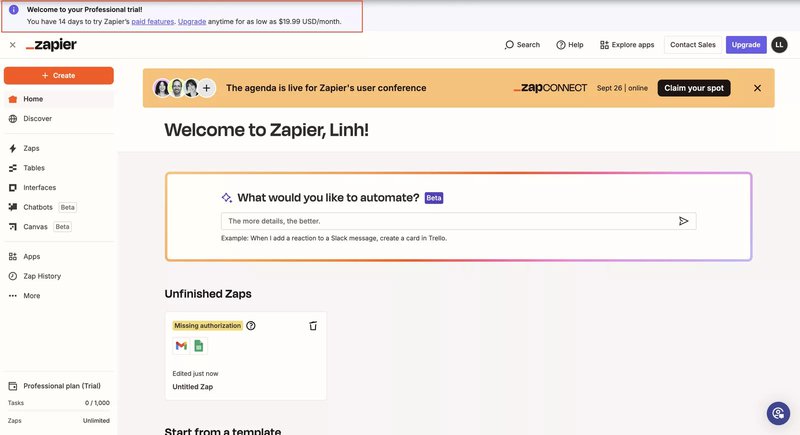
In Userpilot, you can trigger renewal reminders that include upgrade options, either as an in-app banner or as a personalized email sequence. You can create urgency by pairing these prompts with usage data, showing how much value the customer has already gained and what premium option they could unlock.
Personalized upselling
Upsell offers convert better when they feel relevant. By using customer data (company size, role, engagement level), you can tailor messages so they resonate with what each user actually cares about. This strengthens customer relationships and customer satisfaction.
Example: Pendo triggers personalized feature demos based on user behavior and customer data. Instead of generic upgrade prompts, they show relevant features available in higher-tier plans, then offer demos. Users who engage with the demo are more likely to upgrade because the upselling feels consultative rather than transactional.
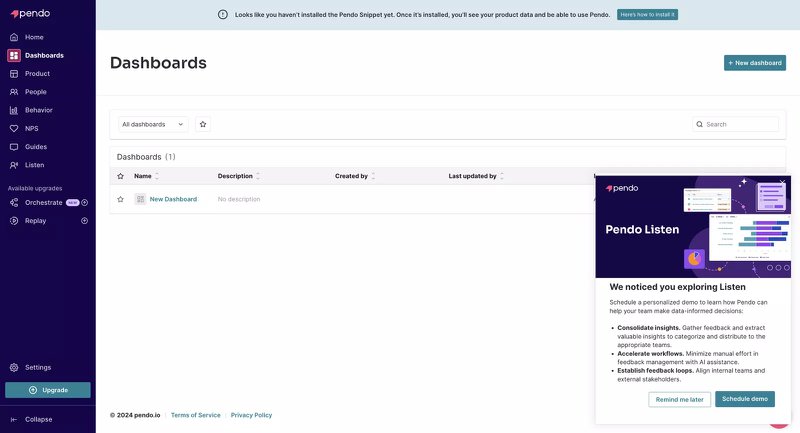
Education-driven upselling
Sometimes customers don’t upgrade simply because they don’t know what’s possible. Education-driven upselling focuses on showing them how premium services solve real problems or unlock new value. This approach builds trust while showcasing additional features.
Example: Asana offers targeted free trials of its premium Portfolios feature. After teams experience how it organizes projects at scale, many choose to upgrade to keep using it. The educational content around this feature plays a big role in conversion, proving that value-first upselling reduces buyer resistance and increases sales.
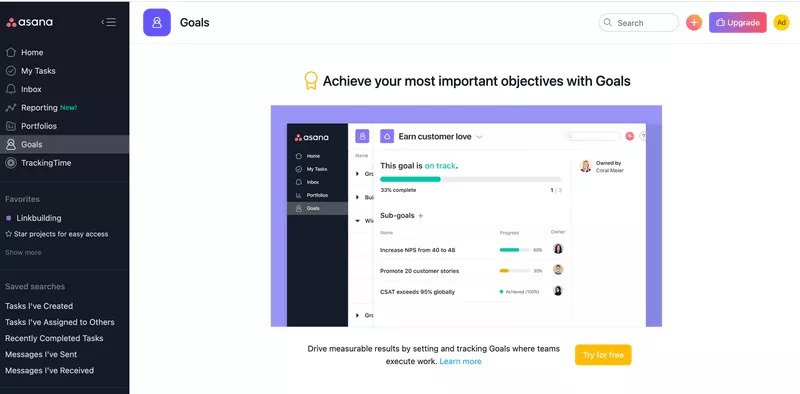
Personally, I’d like to leverage our product, Userpilot, to embed short videos, tutorials, or checklists inside the product. These explain advanced features and invite users to try them out. It’s not just an offer but a learning moment that demonstrates added value.
How Userpilot fuels our upselling success
I use Userpilot to implement upselling strategies without needing engineers for every tiny change. It’s been a game-changer for how my team drives Product-Led Growth.
- Precise targeting: Userpilot’s powerful segmentation capabilities mean our in-app messages reach the right user at the right moment. I can define conditions based on user properties, product usage, or even how they’ve interacted with past content. This ensures relevance and reduces noise.

- Building dynamic prompts: I use Userpilot’s no-code builder to quickly design and deploy a variety of in-app messages. Whether it’s a sleek modal announcing a new tier, a subtle tooltip explaining a premium feature, or an eye-catching banner, I can create it in minutes. You can even save UI pattern templates to keep your designs consistent with the brand.

- Actionable analytics: Userpilot’s product analytics helps us track everything. My team monitors custom dashboards to see how users interact with our upsell prompts, measure conversion rates, and understand how these efforts impact our Expansion MRR. I can view funnel analysis to see where users drop off and optimize our flows using A/B testing. This data-driven approach means we’re always improving.
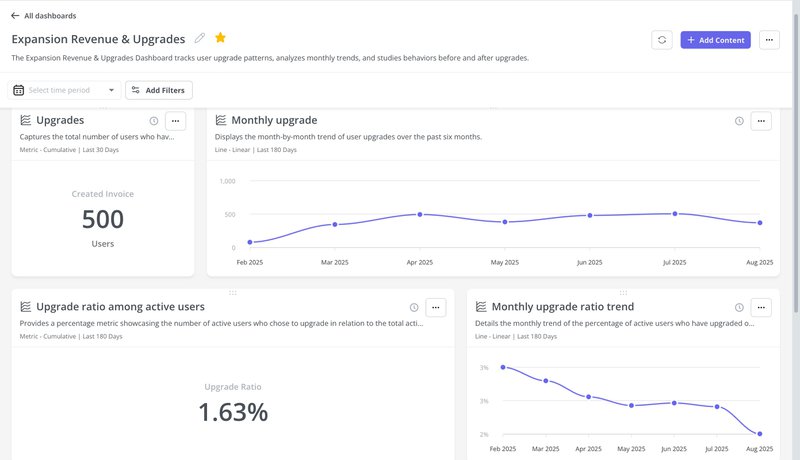
- Cross-platform reach: With Userpilot, you can manage experiences for both web and mobile apps. You can build mobile carousels or slideouts for mobile users, making sure your upsell messages are consistent across all platforms. You can also extend these campaigns through email, so customers receive consistent upsell messages whether they’re inside the product or checking their inbox. This way, you can reach users wherever they are and keep the upgrade path clear across every channel.
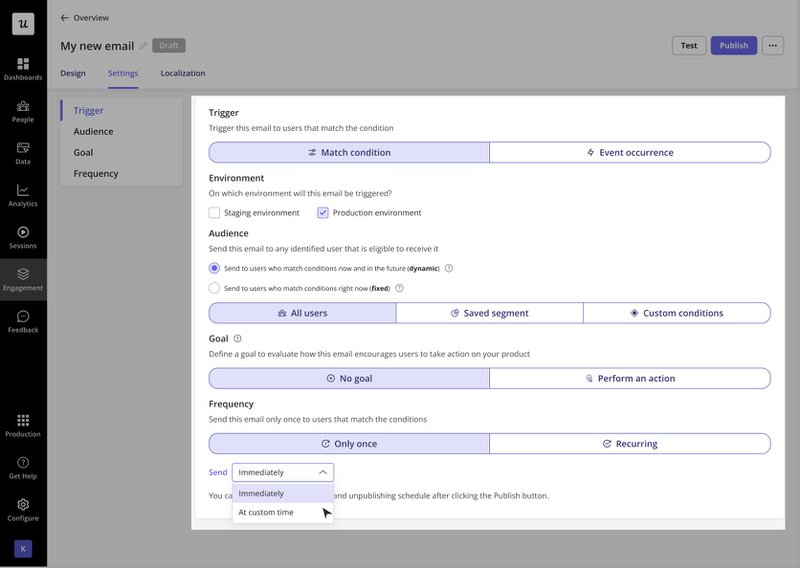
- Integrated feedback: I use NPS surveys and other in-app surveys to collect feedback. This helps me understand why users might be hesitant to upgrade, allowing me to refine my offers and address pain points proactively.
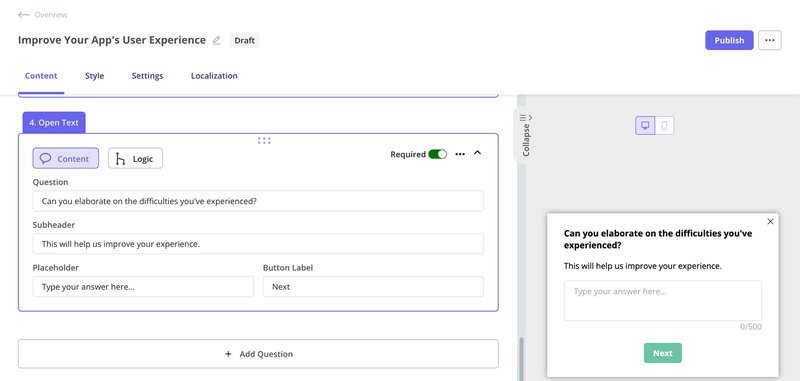
- Automation and localization: Userpilot allows you to automate when and how upsell content appears. Plus, you can easily localize messages for different languages, opening up more opportunities globally.
Ready to unlock more upsell opportunities?
Most SaaS teams leave money on the table because they treat upselling as an afterthought. They blast generic upgrade emails or show random upgrade banners, hoping something sticks.
The companies winning at expansion revenue do three things differently:
- Track user behavior to spot upgrade signals before customers hit walls.
- Deliver contextual offers in the form of helpful suggestions, based on customer lifecycle stages.
- Automate the entire process so opportunities never slip through the cracks.
Want to see how top SaaS companies turn their existing users into their biggest growth engine? Book a demo and we’ll show you exactly how to build upselling flows that convert.

